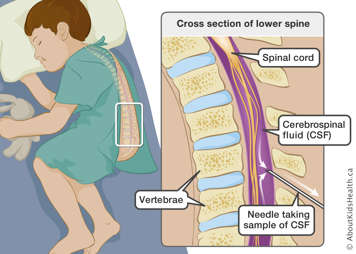A lumbar puncture, also called a spinal tap, is a procedure that takes a sample of your child's cerebrospinal fluid (CSF), which surrounds the brain and spinal cord. Doctors perform a lumbar puncture to see if leukemia has spread into the central nervous system (CNS). If your child’s leukemia has been diagnosed prior to the lumbar puncture, they will receive intrathecal chemotherapy, which delivers chemotherapy medicines into the CSF.
A lumbar puncture usually takes 15 to 20 minutes. It is usually performed by a physician in a day procedure room, but in some cases may take place in the operating room or in the interventional radiology suite. Your child will be monitored by a nurse after the lumbar puncture.
Why does your child need a lumbar puncture?
Our brain and spinal cord are part of the CNS. The entire system is separated from the blood by a membrane. Leukemic cells can cross this membrane and enter the CNS.
Doctors do a lumbar puncture in children with leukemia to:
- Check the CSF for leukemic cells. The CSF acts as a 'sanctuary site' for leukemic cells, which can hide there and escape treatment. Finding leukemic cells in the CSF affects your child's treatment plan.
- Give chemotherapy medicines. If chemotherapy is given through your child's vein (intravenously), many medicines cannot reach the CNS. Your child’s doctor can give chemotherapy while doing the diagnostic lumbar puncture.

Preparing for a lumbar puncture
Your child’s stomach needs to be empty, since they will be sedated during the procedure. Your child’s medical team will let you know when your child should stop eating and drinking on the day of the lumbar puncture.
What happens during the lumbar puncture?
- Your child will have a cream put on their lower back to numb the area 30-45 minutes prior to the procedure. Some older children choose not to be sedated, but still have the cream applied to the area.
- When your child is sedated, they will be attached to monitors which keep track of your child's blood pressure, heartbeat, and oxygen saturation, which is a measure of how much oxygen the red blood cells are carrying.
- Your child lies on their side in a curled-up position for the lumbar puncture.
- After cleaning your child’s back with a disinfectant, the physician inserts a very thin needle between the bones (vertebrae) of the lower spine, and withdraws a small amount of CSF for analysis. CSF typically looks like water. When necessary, the doctor slowly injects chemotherapy medicines through the needle into the CSF space.
- A sample of your child's spinal fluid is sent to a laboratory, which checks the spinal fluid for leukemic cells.
After the lumbar puncture
If your child had a sedative, they may be sleepy, or grumpy. Give your child only small sips of clear liquids such as water or apple juice. Your child may have a regular meal if they feel like eating. Children lie down for approximately 1 hour after the procedure to prevent a headache.
Side effects of a lumbar puncture may include headache, bleeding, infection, and local pain. Neurological symptoms rarely occur.
When your child is fully awake, they may go back to their usual activities.
